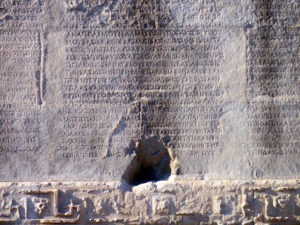Augustus – More than Just the Nativity Story
Caesar Augustus is well-known for the Nativity account of Luke pointing to the proclaimed registration decree.[1] Other little known actions by the Emperor of Rome had further implications long before and after to the accounts written about the life of Jesus of Nazareth.
LK 2:1-3 “…a decree went out from Caesar Augustus that all the world should be registered. This census first took place while Quirinius was governing Syria. So all went to be registered, everyone to his own city.” (NKJV)
 Adopted son of Julius Caesar, his birth name of Octavius was officially changed by the Roman Senate in 27 BC to Augustus meaning “the exalted one.” At that time, the Senate granted him full powers to rule Rome where he reigned until his death in 14 AD.[2]
Adopted son of Julius Caesar, his birth name of Octavius was officially changed by the Roman Senate in 27 BC to Augustus meaning “the exalted one.” At that time, the Senate granted him full powers to rule Rome where he reigned until his death in 14 AD.[2]
Initially, Augustus was one of three triumvirate rulers of Rome along with Marc Antony and Marcus Lepidus. Antony and his lover, Queen Cleopatra of Egypt, allied to challenge the rule of Rome ending with the Battle of Actium in 31 BC.[3]
Antony and Cleopatra had been backed by Herod in the War of Actium. Augustus triumphed while both Antony and Cleopatra committed suicide.
On the losing wrong side, King Herod expected to be executed by Augustus. Figuring he had nothing to lose, Herod traveled to Rome to present himself to Caesar.[4]
After a clever argument, Augustus allowed Herod to retain his crown as Judea’s king and began a life-long positive relationship with the Caesar.[5] Luke referenced Augustus and Quirinius governing in Syria while Herod was King at the time Jesus was born.
Problematic, Quirinius is not considered by secular history to be a governor in Syria until years later in 6 AD raising a question about the credibility of Luke’s account.[6] Unwittingly, Jewish historian Josephus injected Augustus into the timeline enigma with a clue that had nothing to do with Caesar’s registration “census” decree.
Wars of the Jews by Josephus adds a piece to the timeline puzzle by bringing to light an intriguing detail. A letter had been sent by Herod to Augustus asking for official guidance on the sensitive matter of the murder conspiracy trial to kill the King by two of his very own sons and Josephus included Caesar’s response:[7]
“With these directions Herod complied and came to Berytus [Beirut] where Caesar had ordered the court to be assembled…The presidents set first, as Caesar’s letters had appointed, who were Saturninus, and Pedanius, and their lieutenants that were with them, with whom was the procurator Volumnius also…after whom sat the principal men of all Syria…” – Wars of the Jews
Caesar Augustus named two Syria province “presidents” and a procurator to be judges – three Roman ruling authorities who had concurrent governing responsibilities in Syria. Conventional wisdom has been that only one president and one procurator governed a Roman province.
Many governors of Syria over the course of decades were routinely referred to as “president” by Josephus, including Varus. Curiously Josephus, the Roman historian of the Jews, did not ever refer to Cyrenius aka Quirinius as the “president” of Syria.
Had it not been for Augustus’ letter naming Pedanius as another president of Syria, the existence of a second concurrent president of Syria would probably not otherwise be known.
Varus succeeded Saturninus in Syria, Sabinus became Augustus’ Syrian procurator, Jesus was born and King Herod died.[8] Assuming Augustus still recognized two ruling presidents and a procurator in Syria just a few months later, who then was the second president in Syria when Jesus was born – was it Quirinius?
Commencing with the thirteenth consulship of Augustus on February 5, 2 BC, the Roman Senate celebrated his Silver Anniversary as Emperor.[9] To mark the occasion, Augustus was proclaimed Pater Patriae, the “Father of the Country,” an honor included in his self-authored, “The Deeds of the Divine Augustus” (Res gestae divi Augusti).[10]
Treatment of the Jews under Augustus was officially decreed to be in moderation. In Rome’s Temple of Caesar, Augustus had chiseled into a pillar his decree granting the Jews certain liberties and anyone who transgressed this decree was to be severely punished.[11]
After Herod’s death, Augustus decreed the former Judean kingdom to be ruled by the three surviving sons of King Herod – half was granted Archelaus as ethnarch and the remaining half was divided among Philip and Antipas as tetrarchs.[12]
Putting to the test Augustus’ decree concerning the Jews, Caesar stood by his word. Ten years later, after Archelaus failed to govern Judea with moderation, a complaint was lodged against him by “the principal men of Judea.” Augustus banished Archelaus to Vienne, a punishment which had long-term implications for others, too.[13]
Emperor Tiberius adopted the governing philosophies of Augustus including the treatment of the Jews with moderation. This philosophy affected the governing standards of the two Roman Procurators sent to Judea during the 22-year rule of Tiberius, the second of whom was Pilate.[14]
Actions taken by Augustus affected Herod, Quirinius and Pilate – all secular historical figures mentioned in the Gospel accounts who had impacts on the birth, life and death of Jesus of Nazareth. Does this historical information lend credibility to the Gospel accounts about Jesus?
Updated December 2, 2025.
This work is licensed under a Creative Commons Attribution-NonCommercial-NoDerivatives 4.0 International License.
REFERENCES
[1] “Augustus.” Livius.org. Ed. Jona Lendering. 2014. <http://www.livius.org/person/augustus> Tacitus, Gaius Cornelius. The Annals. 14 AD. Internet Classic Archive. 2009. <http://classics.mit.edu/Tacitus/annals.html>
[2] Suetonius (C. Suetonius Tranquillus or C. Tranquillus Suetonius). The Lives of the Twelve Caesars. n.d. <http://penelope.uchicago.edu/Thayer/E/Roman/Texts/Suetonius/12Caesars/home.html> “Augustus Comes to Power.” UNRV History |The Roman Empire. United Nations of Roma Victrix. 2020. <http://www.unrv.com/fall-republic/augustus.php> “Augustus.” Livius.org. “Augustus Biography.” TheFamousPeople. photo. n.d. <https://www.thefamouspeople.com/profiles/gaius-julius-caesar-augustus-779.php>
[3] “Second Triumvirate.” Livius.org. 2015. <http://www.livius.org/articles/concept/triumvir/second-triumvirate>
[4] Josephus, Flavius. Antiquities of the Jews. Book XIV, Chapter 14; Book XV, Chapters V-VI. The Complete Works of Josephus. 1850. Book XV, Chapter VI.1, 5-7. <http://books.google.com/books?id=e0dAAAAAMAAJ&printsec=frontcover&source=gbs_ge_summary_r&cad=0#v=onepage&q&f=false> Josephus, Flavius. Wars of the Jews. Book I, Chapter 20.1-3. The Complete Works of Josephus. 1850. <http://books.google.com/books?id=e0dAAAAAMAAJ&printsec=frontcover&source=gbs_ge_summary_r&cad=0#v=onepage&q&f=false> “Mark Antony.” Encyclopædia Britannica. 2020. <https://www.britannica.com/biography/Mark-Antony-Roman-triumvir/Alliance-with-Cleopatra> Bunson, Matthew. Encyclopedia of the Roman Empire. “Jerusalem.” 2002. <https://archive.org/details/isbn_9780816045624>
[5] Josephus. Antiquities. Book XIV, Chapter VI.5-6.
[6] Josephus. Antiquities. Book XVIII, Chapter I.1. Schurer, Emil. A History of the Jewish People in the Time of Jesus Christ. Volume 1. 1890. pp 350-351. <http://books.google.com/books?id=BRynO3W9FPcC&pg=PP1#v=snippet&q=Tiberius&f=false> The New Schaff-Herzog Encyclopedia of Religious Knowledge. Volume 9. p 375. Doig, Kenneth F. New Testament Chronology. Chapter 5. 1990. <https://books.google.com/books?id=pZJAAQAAMAAJ&pg=PA375&lpg=PA375&dq=Sentius+Saturninus+bio+encyclopedia&source=bl&ots=Yr6hey_Yyt&sig=ACfU3U3_QfHNQxSi3nMAhiiAZdTJqMNr_Q&hl=en&ppis=_e&sa=X&ved=2ahUKEwikl7O2j5_nAhURXM0KHToTC2oQ6AEwA3oECAoQAQ#v=onepage&q=Sentius%20Saturninus%20bio%20encyclopedia&f=false> No Woe Zone. <http://nowoezone.com/NTC05.htm> “Syria.” Regnal Chronologies. 2014. <http://web.raex.com/~obsidian/Syria.html#Syria>
[7] Josephus, Flavius. Wars. Book I, Chapter XXVII.2. Josephus. Antiquities. Book XVI, Chapter XI. CR Josephus. Wars. Book I, Chapter XXXII.1
[8] Josephus. Antiquities. Book XVII, Chapters V.2, VII.1, IX.3. Josephus. Wars. Book I, Chapters XXXII.1, 5, XXXIII.7-8; Book II, Chapter II.2. Gertoux, Gerard. “Dating the death of Herod.” 2015. Academia.edu. 2014. <http://www.academia.edu/2518046/Dating_the_death_of_Herod> Martin, Ernest L. The Star of Bethlehem – The Star That Astonished the World. Chapter 11. A.S.K. (Associates for Scriptural Knowledge. 2003. <http://web.archive.org/web/20190620081117/http://www.askelm.com/star>
[9]Martin, Ernest L. The Star of Bethlehem – The Star That Astonished the World. Gertoux. “Dating the two Censuses of Quirinius.” Augustus. The Deeds of the Devine Augustus. “pater patriae.” Nova Roma. 2007. <www.novaroma.org/nr/Pater_Patriae_(Nova_Roma)> “pater patriae.” Encyclopædia Britannica. <https://www.britannica.com/topic/pater-patriae> Mosley, John. “Common Errors in ‘Star of Bethlehem’ Planetarium Shows.”
[10] Augustus, Caesar. The Deeds of the Devine Augustus (Res gestae divi Augusti). <http://classics.mit.edu/Augustus/deeds.html> “pater patriae.” Nova Roma. Martin. The Star of Bethlehem. Chapter 13. Mosley, John. “Common Errors in ‘Star of Bethlehem’ Planetarium Shows.” Third Quarter 1981, International Planetarium Society, Inc. n.d. <http://www.ips-planetarium.org/?page=a_mosley1981>
[11] Josephus. Antiquities. Book XVI, Chapter VI.2, 8.
[12] Josephus. Antiquities. Book XVII. Chapter XI.4; Book XVII. Chapter XII.2. Bunson, Matthew. Encyclopedia of the Roman Empire. “Galilee; Herod the Great; Jerusalem; Judaea.” 2002. <https://archive.org/details/isbn_9780816045624> Bunson, Matthew. Encyclopedia of the Roman Empire. “Idumaea; Jerusalem.” 2002. < https://archive.org/details/isbn_9780816045624>
[13] Josephus. Antiquities. Book XVII. Chapter XIII.2; Book XVIII, Chapter I.1.
[14] Josephus. Antiquities. Book XVIII, Chapter II.2; VI.5 “Valerius Gratus.” Encyclopedia.com. 2019. <https://www.encyclopedia.com/religion/encyclopedias-almanacs-transcripts-and-maps/valerius-gratusdeg

